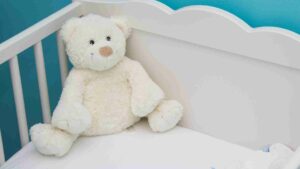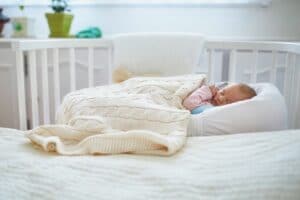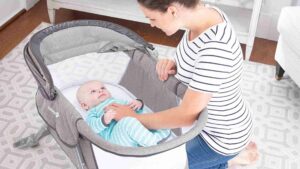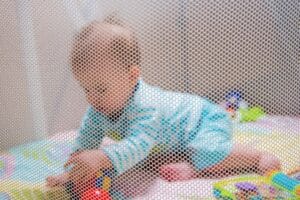Cribs come in two popular types – mini cribs and standard cribs.

The main difference between them is the size of the mattress that they use. Mini cribs usually have smaller mattresses compared to their traditional counterparts.
We take a look at the differences between mini crib and standard, and we find out what you need to know about the two to make the right choice for your little one.
Which Type Of Crib Should I Get For My Baby?
Generally, all types of cribs are designed to provide a safe place for babies to sleep.
They also serve as a nursery or play space for toddlers. In addition to safety, they are also meant to give parents peace of mind.
It can be hard to know which kind of crib you need for your baby. Here’s what you must consider when choosing one.
Size
There are 2 main sizes of cribs:
Mini Cribs
These have small mattresses that are used for up to 24 pounds of beautiful sleeping baby. Depending on the type of mini crib, they can have a range of different features.
Since these cribs come with smaller mattresses, mini cribs are often easier to transport, although not all models are collapsible.
Standard Cribs
Also called full-size cribs, this type of crib has a large mattress that can carry babies and toddlers of up to 35 pounds. The size of mattress used for this type of crib is universal, so it will fit most baby cribs.
Depending on the different crib type, some models even come with little doors or sides that can be moved down.
Safety Features
Safety standards differ among countries; most American cribs comply with US Consumer Product Safety Commission (CPSC) regulations.
Standard cribs are typically manufactured with higher quality standards. They meet US CPSC requirements for durability, strength, and stability. Make sure that you look out for any safety certificates when buying a crib.
Standard Features
Side Rails
All cribs have to have side rails and bars to meet all US CPSC requirements.
A metal top bar with at least 3 sides adds additional support and strength. The more sides, the more robust and more stable the structure.
In addition, the sidebars also prevent the mattress from sliding.
Mattress Height
To reduce the risk of suffocation, mattresses should be about 13 inches high. Typically, most manufacturers make mattresses with heights ranging from 12½ to 14 inches.
Tilt Mechanism
Tilt mechanisms allow parents to raise the mattress if necessary. Not all cribs have a tilt mechanism, but for those that do, you can set it to the “up” position which then tiltes the mattress up but remains attached to the crib.
Parents can adjust the tilt angle by moving the mechanism to other places.
Latch Handles
Latch handles secure the mattress to the crib during transport or storage.
Bed Frame
The type of frame is essential as it gives the crib its stability and structure. Crib bed frames are usually made of metal or wood.
Firmness
Firmness refers to the pressure when an infant lies on the mattress, similar to a normal bed mattress. Crib mattresses should be firm to support baby’s body perfectly.
Dimensions
Width/Length
A crib should measure roughly 52″ wide by 36″ long. That length includes the bottom rail, mattress, and headboard.
Height
By law, cribs must be around 26″ high. This height allows the infant to stay safely inside the crib, while the mother can also easily reach inside to lift the baby out.
Weight Capacity
Mattresses should weigh roughly 25 to 30 pounds. This weight capacity depends on the manufacturer’s recommendations, and you should check the product description carefully to ensure that the crib can carry your child’s weight.
Door / Panel
Crib doors or panels allow parents to access the crib from the side. Sliding panels can also provide better visibility of the sleeping child.
It’s Important To Follow Manufacturer Instructions
Your baby’s first step toward independence begins when he or she learns to crawl.
Properly installing furniture in your home helps keep the baby safe as they explore new surroundings. That’s why, make sure that you always follow the instructions provided by manufacturers.
How To Choose A Crib
Choosing the correct type of crib can be confusing as there are many types available, including standard and mini cribs.
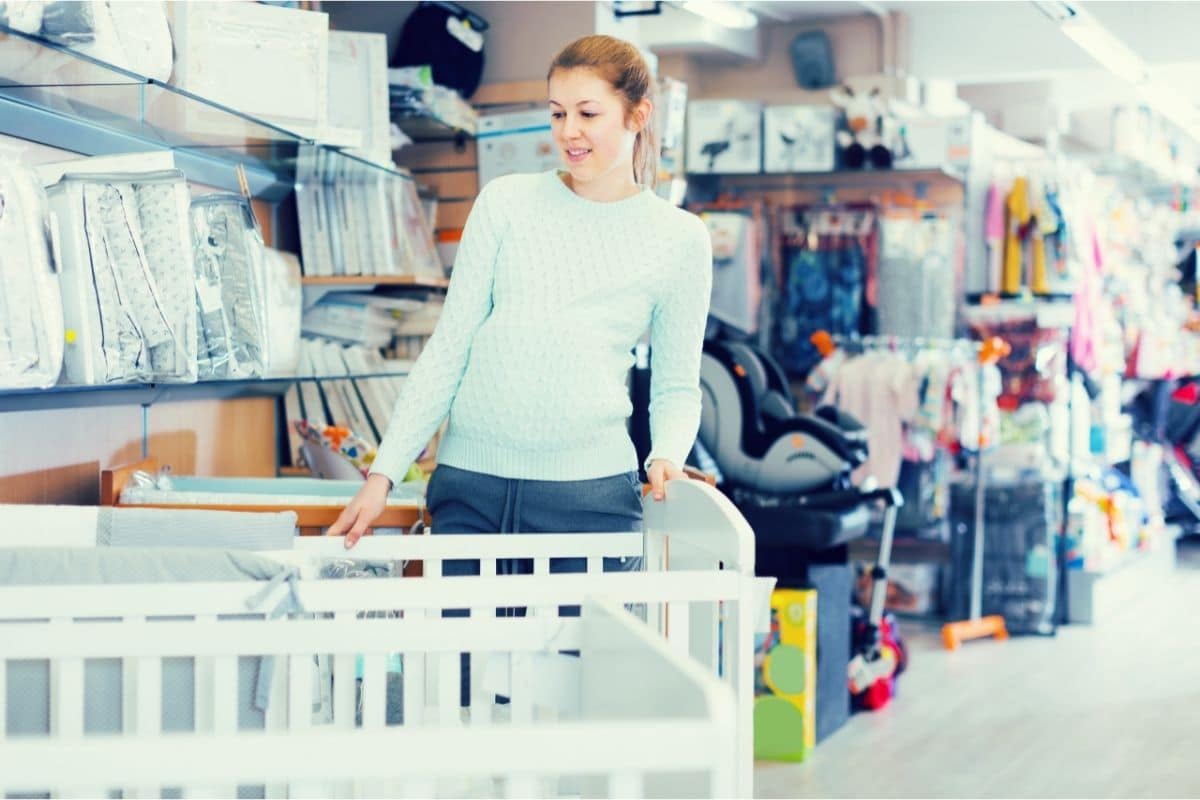
It’s essential to understand what you need before making a purchase because a wrong choice could lead to an unsafe environment for your child.
If you buy a crib that doesn’t fit in the room where it will be installed, you may struggle to move around the room with ease. You also want to consider whether the size will match your nursery’s changing table, playpen, and bassinet.
Ask family members and friends for their input. Many people have used cribs in their own homes, and they will a lot of valuable experience.
Ask which models were easy to use, and what problems they had with previous purchases. This information can help you avoid buying something that has been recalled or isn’t working well.
Look around your house. If you already have children, then look at old cribs that you already own. Are they still usable? Do they look like they’re in good condition? If so, try using one instead of purchasing a brand-new crib.
Visit local stores. Your local store may offer free in-store demonstrations. These shows usually include small displays that show off the various products. Knowledgeable sales staff can also answer any questions you have about how to choose the right crib for your child.
Check online forums. Some manufacturers list detailed reviews of cribs. Other companies post videos showing how to assemble cribs. Before deciding on a particular model, check these reviews.
Considerations Regarding Crib Safety
Crib Safety
Some features make cribs a very safe sleeping space for children of babies and toddlers.
For example, the majority of cribs come with a guardrail system and side rails. Guards are metal bars that extend vertically along each side of the crib.
Side guards are similar, but only go halfway down each side. They are intended to prevent infants from falling out of bed.
Crib Bumper
The bumper is another feature that provides additional protection for your child. Crib bumpers keep your baby safe from banging their head against the side bars while sleeping.
They can be made out of different types of fabric with padding inside. You simply place a crub bumper around the inside edges of your crib.
Mattress Size
When choosing the right-sized crib mattress, think about your child’s size. You need to make sure that your little one has enough space to move around.
You’d be surprised how much even newborns move in their sleep! That’s why, make sure that there is plenty of mattress space, and also consider how quickly your child will grow.
After all, you do not want to spend money on another crib in half a year’s time.
Childproof Latch
To avoid injuries caused by toddlers climbing out of the crib, choose a latch that requires two hands to open.
Most crib doors come with latching mechanisms that require one hand. The second latch should be positioned behind the door. This reduces the risk of children opening the latch unintentionally.
Slats
Slats allow air to circulate underneath the crib mattress. This helps keep a baby comfortable in warmer climates.
Side Panels
Cribs often come with either side panels or a meshed side that allow for a quieter, more relaxed sleeping environment.
Other Safety Features
Cribs generally come with a lot of safety features as these items are heavily regulated by different laws and regulations.
When you are looking to buy a crib, find out about its safety features.
How To Choose A Crib That Suits Your Interior Design Style
Choosing a standard crib or a mini crib depends on your personal preference and also the space you have available in your nursery.
Measure Your Space
In order to ensure that your crib fits into your room, take the following measurements using a tape measure: height (from ceiling to bottom rail), width (side-to-side distance), and depth (depth of the crib). Choose a crib that fits into your chosen space.
Consider The Room’s Decor
Consider the style and color of your room. It’s best to choose a crib that fits harmoniously with your home decor.
Check Storage Options
Make sure that the crib has easy-to-use storage options. For example, some cribs come with additional storage pockets or storage draweres where you can store essential baby items.
Check Safety Features
Consider the safety features of your new crib. Some models include:
- Handles: These sturdy handles give parents a way to pull their child out of the crib.
- Safety Grids: A grid system, also known as a crib bumper keeps your baby from bumping his/her head against the crib bars.
- Guard Bars: Guards reduce the chance of fingers being trapped between the crib’s bars. Many models are designed with this in mind already, but as your child grows, it is more likely that he/she can get her hands and fingers stuck between the narrow bars..
- Headboards and Footboards: Headboards offer extra support for your baby’s neck while lying flat. They also help ensure that the bedding does not slip down, making it difficult for babies to get back to sleep.
Look at accessories like a bumper guard, mobile, or play yard. You can purchase these items separately or as part of a package together with the crib.
Find Out Warranty Details
Check the manufacturer’s warranty to see how long it lasts, and also ask what happens if the product malfunctions during the first year.
Will it still be covered by warranty? What is the service policy, and will you have to pay to return the crib?
Consider Buying A Package Deal
This is likely to save you money over time. For example, it may be cheaper to buy a crib and other pieces together than purchase them individually.
Install With Care
Once the crib arrives, check the packaging carefully for any damage. Then you can start to put the crib together. Depending on your chosen model, this may require a little bit of time and patience.
Once you put the frame together, you can place the mattress inside the crib. Then, put the mattress cover and sheet on the mattress. Your baby should not have any pillows or other things in the crib as this could lead to suffocation or cot death.
Do A Baby Test Sleep
Once you installed your crib and it all looks good, you are ready to place your little one inside the crib. Gently, place him on his tummy, and roll him around to make sure he doesn’t fall into any gaps on the side.
When placing the baby in the crib, it’s best to follow the instructions given by the manufacturer. Try not to put the baby near the crib’s edge, instead let him lie centrally within the crib.
Finally, place a soft crib bumper on either side of the crib to balance the baby. Even the tiniest newborn should sleep comfortably in a firm crib.
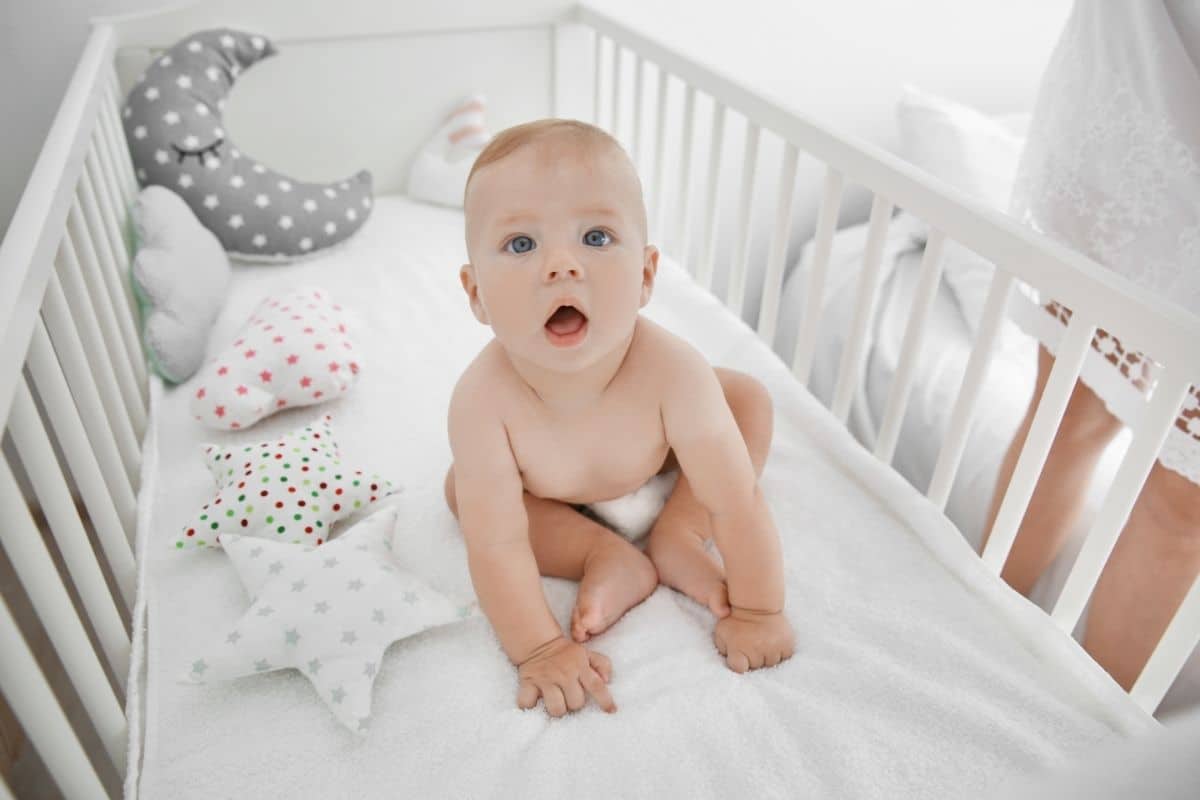
Considering The Bar Width On Cribs
For safety, it’s essential to measure how wide the bars are on a potential crib for your nursery. This is important as your child may get his hands or fingers trapped between the bars.
SSome very young child may even get their head stuck between bars that are spaced wider, so make sure that the spacing between the bars is relatively small but not small enough so they can get their hands stuck.
Considerations For Selecting Your Baby Bedroom Furniture
You’ll want to choose furniture that fits your needs in style and size. Here are some things to keep in mind:
1. Choose a mattress that is appropriate for your child’s age. Babies 3 months old and younger usually need a firm mattress.
As they grow older, they might require a medium-firm coil spring mattress and eventually a twin or dual-layer bed of coils and foam layers.
2. Remember that cribs of any size take up floor space. Keep this fact in mind when shopping for furniture. Try to find furniture that has plenty of storage space.
Your child will feel more secure having an ample amount of toys, books, and blankets, and it gives you peace of mind when you know you can store them somewhere.
3. Make sure the furniture you select is strong enough to withstand frequent use. Avoid cheap-looking or weakly constructed furniture. Instead, get the best quality furniture available.
4. Furniture is heavy! So, make sure that you secure it safely to the wall and that it stands evenly on the floor.
5. For added comfort, pick a crib cumper that supports your child’s busy sleeping pattern.
6. Use a bedside lamp to provide light at night. Many parents prefer reading lamps, especially those that cast a warm glow instead of the bright glare associated with many bulbs. In addition, look for lights with dimmable features.
7. A dresser or chest can serve as a changing table when necessary. You can use it as a surface to lay your child on when changing your little one’s nappy.
Tips For Designing A Nursery
To effectively design a nursery, start with the basics. Think about the theme you’d like to establish. What colors would work?
How much natural light do you want to allow into the room? Do you plan to add artwork?
In addition to considering fundamental decorating issues, also think about what kind of activities you hope your child will enjoy in the new room.
Would you like to play some music to your child? Do you want to read stories to them, or will you both be drawing pictures?
Before you start designing your new nursery, you need to allocate either a room or a certain space in your home to become the nursery.
Make sure that the room is easily accessible. Ideally you should use a space that is close to your bedroom and living space, so that you are always at hand when baby is waking up.
Once you’re done planning, it’s time to get started. First, create a budget, and set aside some funds for painting supplies and other items needed to complete the job.
In short, prepare your finances in advance, so you won’t be surprised by expenses during the project.
Another essential thing to remember: Don’t try to tackle everything all at once. Doing so could result in an expensive mistake. Instead, divide the project into little steps.
Start out slowly, so you don’t get discouraged. And remember that even the most minor details matter – from choosing color schemes to picking wallpapers to select lighting fixtures.
One last thought: Before making any final decisions, check in with friends and family who have children. They may be able to give you valuable tips.
This is especially true if you know anyone who has recently given birth to a newborn. They may be able to offer some great insight into how infants behave and develop. So feel free to ask them for their opinion.
Baby Care Tips For New Moms
Becoming a new mom is one of the most wonderful times in a woman’s life. But it is also a very busy time where all attention is naturally focused on the new arrival.
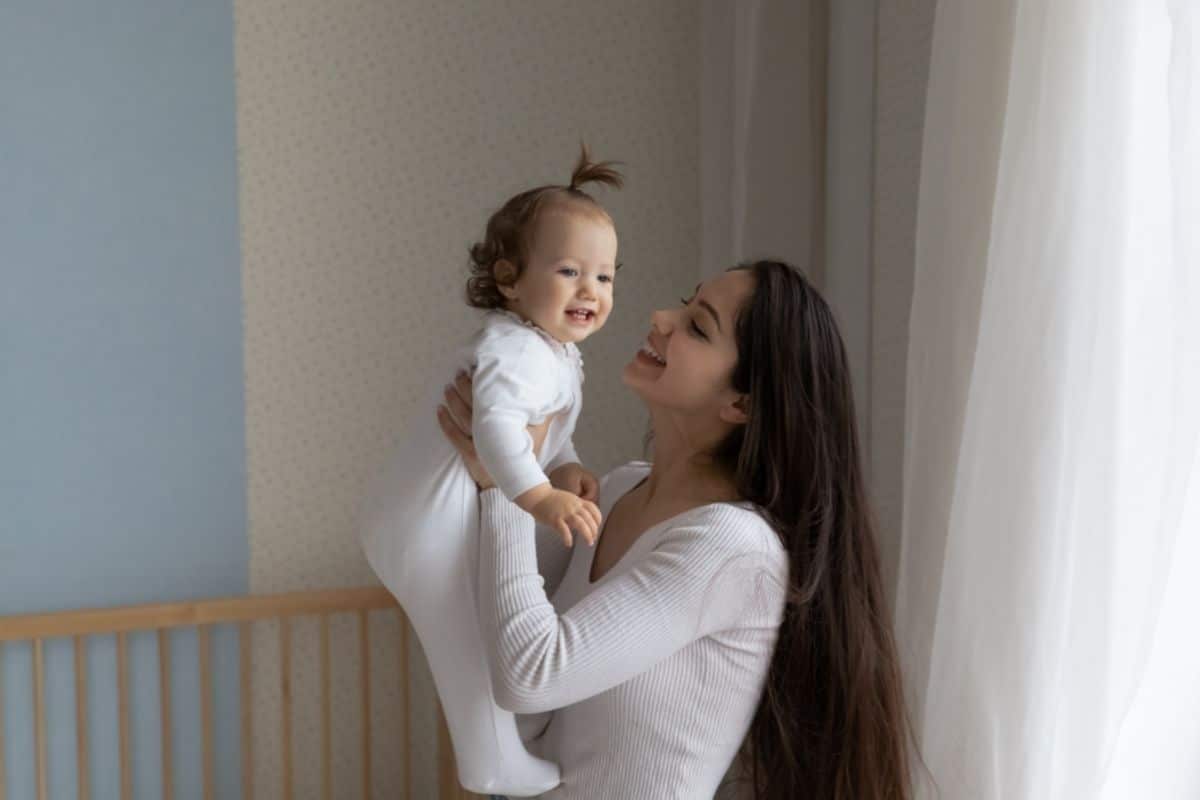
If you notice extreme sadness or feel overwhelmed, there is no shame in contacting your friends, family or doctor to ask for help.
If you didn’t receive prenatal care, or you experienced medical complications during labor, you may need more than just help with everyday tasks. Your doctor will be able to give you plenty of advice on how to look after yourself.
Alternatively, there are also a lot of forums and social groups that support new moms with the challenging first weeks, months and years.
When coming home with your baby, it’s a good idea to get as much rest as possible (and we know it isn’t always possible!).
Try to avoid eating foods high in fat, sugar, and salt, as they can make you feel fatigued and sluggish. Also, avoid caffeine which prevents you from having a well-deserved rest.
Don’t try to take on too many household chores at one time. Instead, give yourself enough time to rest. Also, make sure someone else is there to help you either daily or a few times a week.
Even just another family member looking after your baby for an afternoon can give you some time back to do the things that make you feel relaxed.
Babies’ stomachs aren’t as big as adults’, so they often eat smaller portions and fewer calories more oftenn. That’s why, plan ahead for feedings and start a little daily schedule.
Baby skin is extremely sensitive and there is always a high risk of irritated skin with babies. The best way to prevent diaper rash is to use natural products. Choose unscented diapers and wipes., and be sure to change diapers frequently.
Conclusion
To conclude, there are various reasons why parents choose a particular type of crib. Some families opt for a mini crib because they do not have enough space for a standard crib.
The nursery for your little one is not just a playroom but also a save sleeping space. You will need to consider how you want to divide the room before choosing a crib.
Small cribs are becoming quite popular in today’s homes. They are often used as an alternative to a standard crib, but they come in different sizes.
The mini crib is usually a great option when you want to save space, and money.
A small crib is designed to fit into smaller spaces than a regular-sized crib. The mattress used is usually thinner and the legs of the frame are shorter.
These are one of the most compact types of cribs on the market. But if you do have plenty of space in your nursery, then you cannot go wrong with a standard crib which gives your baby plenty of space to move around, and also to grow.

Carly Link, a 33-year old mother of two toddlers. She is a parent and goes through a lot of the usual parenting difficulties herself. Carly shares all her experiences and knowledge about the best baby products through this blog.

